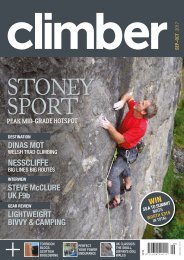Singletrack
You also want an ePaper? Increase the reach of your titles
YUMPU automatically turns print PDFs into web optimized ePapers that Google loves.
We looked at samples of 2018 bikes – the rear triangle<br />
of the Myst now has a three-position dropout and this had<br />
been constructed in a 3D model, attached to a regular carbon<br />
swingarm. This is often machined or printed from solid plastic<br />
to allow regular components to be fitted into place to check<br />
fit. There were also colour samples to check on frame tubes.<br />
While Pantone colours and paint chips can go a long way to<br />
standardising colours, nothing beats seeing a painted frame in<br />
real life rather than rendered on a computer screen.<br />
Composite Gear’s factory was a much bigger outfit than<br />
I’d seen so far. It was both more high-tech and low-tech than<br />
I’d imagined. CNC plotters precisely cut carbon sheets, which<br />
were then laid up precisely according to a very strict menu of<br />
what went where, yet in another room, freshly made, high-end<br />
time trial frames sat in a big bucket as they came out of the<br />
moulds, before going to be finished and beautifully painted<br />
and decaled and sold for thousands. On one machine, prebonding<br />
surfaces were precisely machined and cleaned before<br />
glueing. On the next machine, a guy seemed to just eyeball<br />
the drilling of a shock-mount hole. And while that might be<br />
entirely in tolerance, these things are often why designers like<br />
to see the whole process for themselves before just assuming<br />
that the factory is doing what it was meant to.<br />
Generation Game.<br />
An example layup demonstration for a Kili Flyer was set<br />
up for us in the clean layup room. A worker moved with<br />
effortless grace as she built up layers of carbon prepreg sheet<br />
around a plastic-coated wooden form. Layer after layer went<br />
on according to the predetermined menu as she added large<br />
sheets and smaller reinforcing ones, all cut and oriented to<br />
maximise the stiffness of the carbon fibres. When it was done,<br />
she whipped out the wooden form to leave a hollow, but still<br />
floppy carbon tube ready to be joined onto other frame parts<br />
before it went into the oven. We then saw the pieces go into<br />
another, female wooden form for the head tube to be wrapped<br />
on. Then the front end was fitted with bladders and ready for<br />
cooking in a heated steel mould.<br />
While a company like Hope can painstakingly cut and<br />
beautifully lay material directly into the final mould, they’re<br />
only making a frame or so a day. At CG the moulds can’t be<br />
left idle for a moment and they’re not even cool before the<br />
next frame is fitted in and sent to be baked for 90 minutes.<br />
Simon was invited to try his hand at laying up a top tube.<br />
Even though to our eyes he did a good job of peeling off the<br />
backing and smoothing down his tacky carbon sheet on top<br />
of the others, our carbon mistress wasn’t happy and pulled it<br />
off again, smoothing it back down again with an expert touch<br />
that I can only equate to how a master sushi chef crafts a maki<br />
roll.<br />
Rob Crayons does like.<br />
Simon making sure the colours are true.<br />
19






